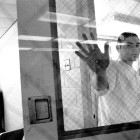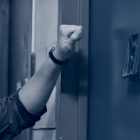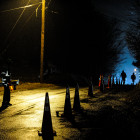

An 11-year-old denied making a threat and was allowed to return to school. Tennessee police arrested him anyway.
|
In late September, Torri was driving down the highway with her 11-year-old son Junior in the back seat when her phone started ringing.
It was the Hamilton County Sheriff’s deputy who worked at Junior’s middle school in Chattanooga, Tennessee. Deputy Arthur Richardson asked Torri where she was. She told him she was on the way to a family birthday dinner at LongHorn Steakhouse.
“He said, ‘Is Junior with you?’” Torri recalled.
Earlier that day, Junior had been accused by other students of making a threat against the school. When Torri had come to pick him up, she’d spoken with Richardson and with administrators, who’d told her he was allowed to return to class the next day. The principal had said she would carry out an investigation then. ProPublica and WPLN are using a nickname for Junior and not including Torri’s last name at the family’s request, to prevent him from being identifiable.
When Richardson called her in the car, Torri immediately felt uneasy. He didn’t say much before hanging up, and she thought about turning around to go home. But she kept driving. When they walked into the restaurant, Torri watched as Junior happily greeted his family.
Soon her phone rang again. It was the deputy. He said he was outside in the strip mall’s parking lot and needed to talk to Junior. Torri called Junior’s stepdad, Kevin Boyer, for extra support, putting him on speaker as she went outside to talk to Richardson. She left Junior with the family, wanting to protect her son for as long as she could ...

The Economics of Juvenile Justice
|
Our Constitution sets forth in the preamble that one of the goals of government is to "promote the general welfare." This requires good policy decisions by our leaders that promote a strong economy. We are fortunate living in the land of the "free and the brave"—to exercise freedoms others only dream of. And many have money in their pockets to feed their family. Is it because we are one of the wealthiest nations in the world that we take economics for granted when it comes to criminal and juvenile justice issues?

What We’re Here For: The Role and Purpose of Juvenile Detention in the 21st Century
|
Across the nation, perspectives on juvenile detention are changing. Several experts share how they believe modern juvenile justice is implementing more rehabilitative models and what the ultimate dividends may be for both young people and U.S. society as a whole
Mike Rollins, executive director of Coosa Valley Youth Services (CVYS) in Anniston, Ala., has been at the facility for more than 30 years. His experiences, however, aren’t just limited to working there. At 17, Rollins walked into CVYS for the first time. “I was engaged in drug use,” Rollins said.

Prison Photography: A Memory Divided
|
This month, Youth Today features an essay by Prison Photography writer and editor Pete Brook. Brook highlights three photographers and their work, each focused on incarcerated young people from different detention centers across the country. Youth Today, a publication dedicated to providing juvenile justice stories as well as stories on other youth related issues, features the entire photo spread in its January print edition. Read an excerpt of the piece below:
Hundreds of thousands of people see inside the places and spaces where we lock up young members of our society. On any given day, more than 60,000 children in the United States are behind bars.

Calculating the Cost of Trying Juveniles as Adults
|
Many analysts and policymakers say that the practice of trying juveniles as adults is costly, but the Center for New York City Affairs at the New School recently came up with an actual price tag; according to a report published in the latest issue of “Child Welfare Watch,” the long-lasting economic effects of trying just 800 to 1,000 New York teens as adults may result in as much as $60 million in cumulative lost income. New York, alongside North Carolina, is one of only two states in the nation where the age of criminal responsibility is lower than 18. Analysts say that New York’s policy, which is applicable to nonviolent offenders, reduces each convicted teen’s lifetime earnings by more than $60,000 - in total, estimating the state will lose a minimum of $50 million in income. Not only do criminal records have massive detrimental effects for young people tried as adults, but the analysts say that doing so also costs the government “untold millions” in lost tax revenue. Analysts note that two legislative efforts to alter that state’s criminal procedures have recently been submitted to the New York Assembly and Senate.

The Horror of Newtown must Never be Normal
|
Pop quiz: What do the towns of Norcross, Chardon, Pittsburgh, Oakland, Tulsa, Seattle, Aurora, Oak Creek, College Station, Minneapolis, Brookfield, Happy Valley, and Newtown have in common? All of these communities were the sites of a “mass shooting.”
The last one may have given away the answer, but then again, by the time this is published several days will have passed since the shootings at Sandy Hook Elementary School, and Newtown will have already begun to fade from public awareness. Here is another one: How many teens and kids were killed this past summer in Chicago? The answer is 38. For those interested, Complex magazine offers a tribute to each of the young people.



